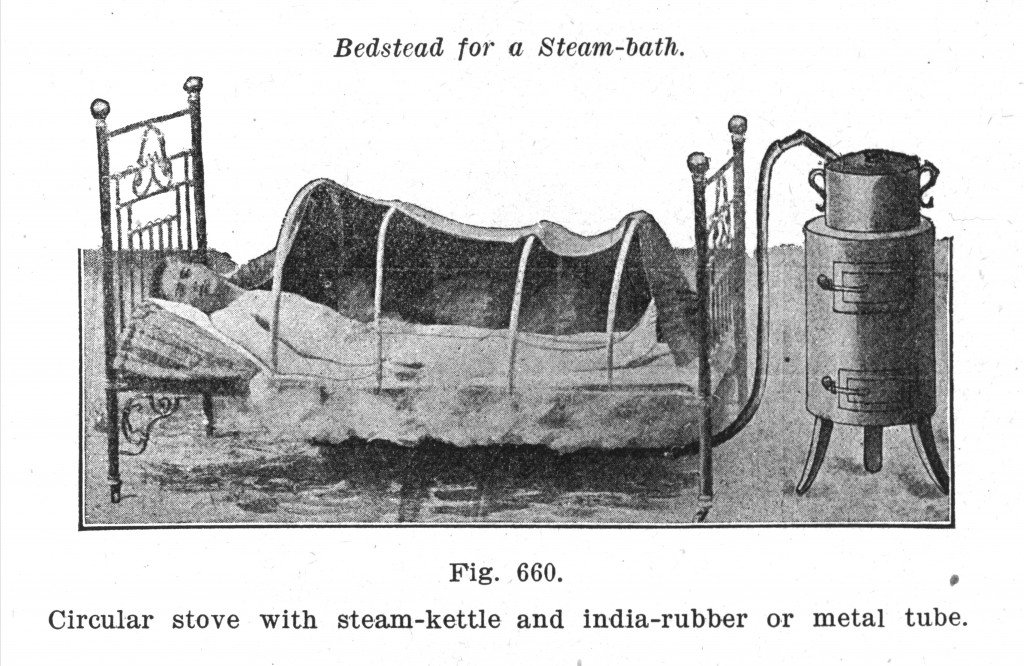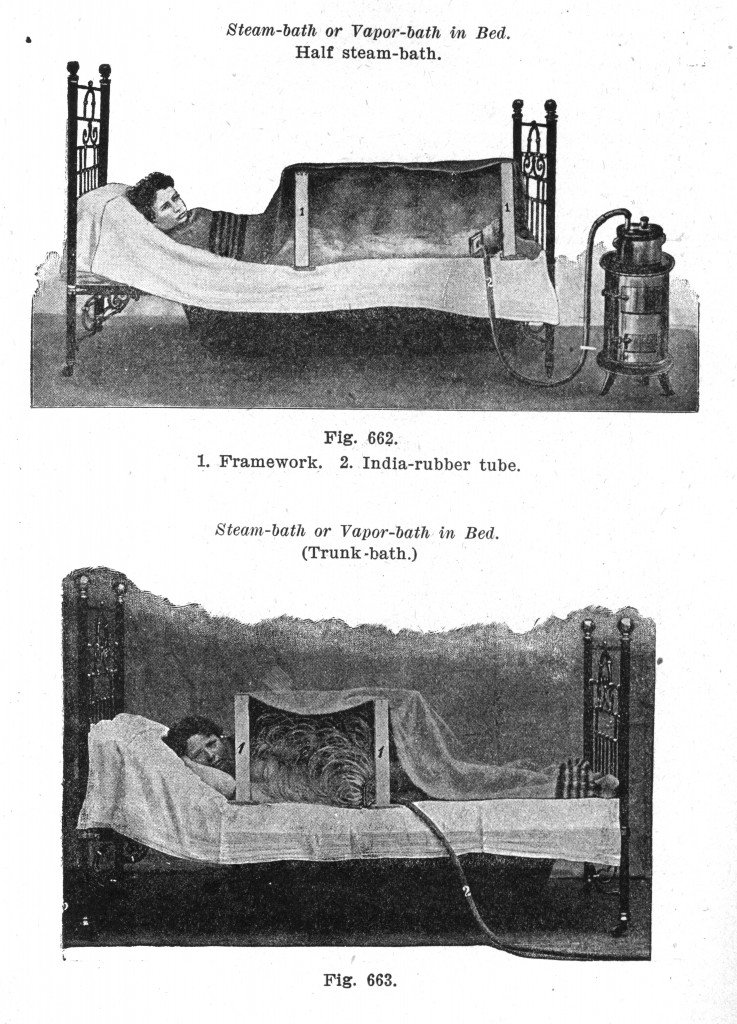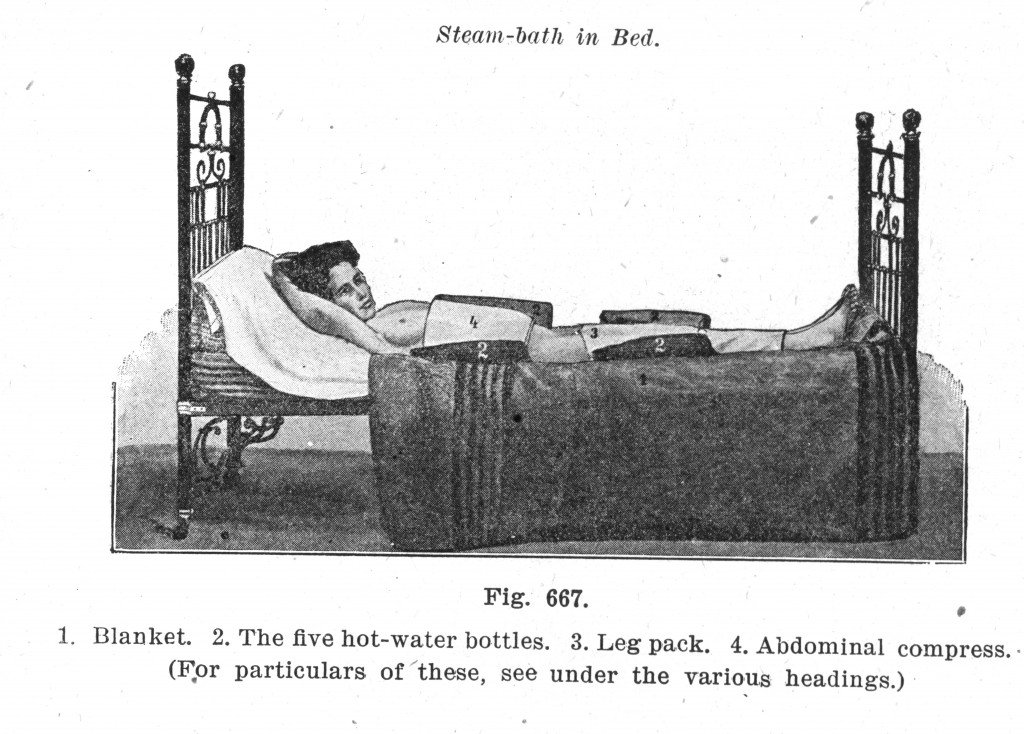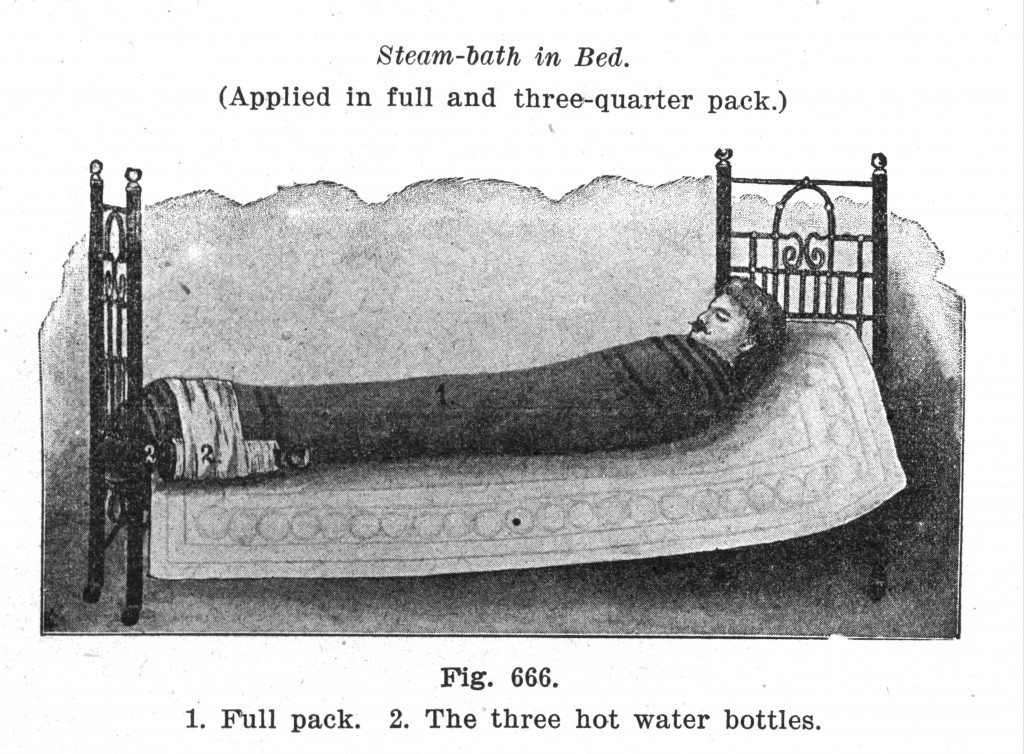Sussanna Czeranko, ND, BBE
Every steam bath should be succeeded either by a lukewarm bath (88° F/31° C) or by a tepid wet rubbing of the whole body (73° F/23° C), the former for young children, the latter for adults; but in the first case a stimulating full or three quarter pack should follow.
-Friedrich E. Bilz, 1898, p.1919The best thing, suitable for every patient, is always the universal remedy, the steam bath in bed and he should never wait till the disease has quite broken out and till he knows what disease it is, but the great point is to nip it in the bud, to take preventive measures at its very first appearance.
-Friedrich E. Bilz, 1901, p.287The vapor bath is a powerful eliminative measure.
-John H. Kellogg, 1904, p.705
Re-encountering the term “steam bath in bed” during my research of the Benedict Lust literature, I assumed at first that I understood what the early Naturopaths were talking about. However, while studying a passage by Friedrich Bilz in an article, “Bad Health,” published in Benedict Lust’s journal, The Kneipp Water Cure Monthly, I realized that I had no idea how to administer this therapy. Here was one of my pioneering nature-cure heroes, Bilz, describing strong familiarity with the therapy and praising it as “the best thing, suitable for every patient… always the universal remedy, the steam bath in bed.” (Bilz, 1901, p.287) Bilz was describing the steam bath as if it were a compress, and that left me muddled. Ah, the sobering moment when curiosity gains the upper hand and I committed to a more thorough search of the literature to investigate the story behind this therapy that many at the time considered indispensible in the treatment of acute and chronic diseases.The old literature of naturopathic medicine pulls back into our view old words, ideas, and therapies which prove timeless for us. Some of the names of old and forgotten therapies are self-explanatory, and we can quickly figure out what the therapy entails. In the case of the phrase, bed steam bath, though, I found myself stumped at first. I tried to conjure up an image of the possible schema that this bath could take, and what I discovered in the literature was a complete surprise. For starters, the steam bath in bed had many variations, depending upon the writer, and could be achieved by using a wide variety of methods to generate steam, both exogenously and endogenously. It was only until reading more widely about the bath and discovering surviving images that my imagination let out the clutch with rather nifty, quite possible adaptations of the steam bath in bed for a modern naturopathic practice.
There are as many inferences as direct references to the use of steam baths in Lust’s publications. Although there were many Naturopaths who used them, 2 stand above the rest: Louis Kuhne and Friedrich Bilz. Louis Kuhne in his treatment protocol relied principally upon a vegetarian diet and 2 hydrotherapies, of which the steam bath was 1, second to his famed and infallible “friction hip bath.” Bilz also placed the steam bath high on his list, anointing these simple baths as the “universal remedy” and devoting many pages in his writings to the subject. Another, who did not submit many articles to the Lust publications, yet who wrote copiously on what he called the “vapor bath,” was John Harvey Kellogg.

The steam bath in bed differed from the Russian bath or the Turkish steam bath. The steam bath in bed was passive. It entailed the patient lying in a bed for 45 min to 1 1/2 hr. In the Turkish bath, on the other hand, the patient was often seated in a room that was equipped with a furnace to create the steam and the heat, with a bath attendant on hand who would use friction, massage, and kneading of muscles to promote perspiration. “In [the Russian] bath the patient lies upon a slab in a small room filled with steam, being rubbed at intervals by an attendant so as to promote the early appearance of perspiration.” (Kellogg, 1904, p.698) However, a steam bath is not a steam bath in bed. In this regard, Benedict Lust recognized the merits of the steam bath, and wrote an article on the subject in his first English issue of The Kneipp Water Cure Monthly in 1900: “There is no better medium than the steam bath to free the body of all superfluous water and to restore the ability of nerves and muscle.” (Lust, 1900, p.20) The steam bath in bed was a similar experience, but different in many respects.
The Steam Bed
The steam bath in bed required a special bed devised for this bath. Bilz used a single bed with “short legs and cane bottom similar to that of a chair, for the steam to pass through, and [the bed had] no sides.” (Bilz, 1898, p.1902) To provide a structure to contain the steam, the bed had rods attached on its sides on which to drape a canvas cover (Figure 1). Bilz devised a system where the patient did not come into contact with the draping material, whereas Kuhne simply had the patient lie on the bed and be covered with woolen blankets that hung over the sides of the bed “loosely on either side [of the bed], far enough to prevent any steam escaping.” (Kuhne, 1917, p.359)
The patient’s head remained outside of the tenting material and the cover was drawn tight under the patient’s chin, about his or her neck, so the head was free and the steam could not escape.” (Bilz, 1898, p.1902) Another variation of the bed used also included a wire bed frame with wire springs. Cloth was laid onto the wire springs to provide some patient comfort. Another option cited by Bilz was devising a bed of wooden laths which allowed steam to be directed below the bed and permeate upward through the spacing of the wood laths.
The patient would lie on the bed and another person would ensure that the blankets or canvas draping the bed and patient were such that no steam escaped from the enclosure.
Steam

The production of steam in the 19th century required much ingenuity, and it is clear to see that these early innovators used the resources at hand. Before the advent of electricity and modern-day plumbing, steam production at the bedside was tricky and required skilled, inventive engineering. Viewing the “steam kettle” of the 19th century, one may consider its simplicity on first glance as a key element in an apparatus with 1 part, a unit with a lower compartment, benefitting from a heat source obtained either by a small gas or kerosene stove heating a water compartment above. Elaborate for its time, the steam kettle’s purpose was to boil water, produce steam and then distribute the captured steam, either by a rubber hose or a metal tube, safely to the patient lying in the bed (Figure 2). Many of the images showing the various “steam kettles” appear to be very compact, clever, and perhaps even brilliant innovations.
Louis Kuhne, ever the innovator, devised a “steam pot” that used an alcohol heater which dispensed with wood or coal. Akin to the modern gas stove, a heating source derived from burning alcohol was a novel, cleaner invention at the time [1880s].
Not surprising, terms naming equipment used in the steam bath varied between doctor and practitioner. For example, John Harvey Kellogg’s massive book, Rational Hydrotherapy, had added enormously to understanding the benefits of this long-forgotten therapy. Kellogg referred to the steam bath as the vapor bath, and he gives an account of Wilhelm Winternitz’s innovative steam bath taken in an ordinary bathtub. Winternitz devised “a board of a size sufficient to support the patient, and perforated with inch holes laid in the tub and raised by proper support three or four inches from the bottom.” (Kellogg, 1904, p.701) A hose was attached to the faucet and laid down under the board to the head of the tub. As hot water emptied into the tub, steam was generated, and with the tub unplugged, hot water left. “The vapor is retained about the body of the patient by blankets placed over the top of the tub, and tucked around the neck in such a way as to protect the head from the warm vapor.” (Kellogg, 1904, p.702)
Patients were instructed to change their position often. Bilz advises, “It is best for the patient to be on her/his side and to change her/his position every six or eight minutes, so that the steam may act equally on every part of the body.” (Bilz, 1898, p.1906) To avoid over-heating, patients were encouraged to drink water during the steam bath in bed. Bilz also emphasized that the patient’s “face, forehead and neck should be sponged or wiped with a sponge or cloth dipped in cold water,” although he noted that “some prefer to have a wet cloth on their head all the time.” (Bilz, 1898, p.1906)
After the Steam Bath
To maximize the benefits of the steam bath in bed, patients were instructed to rest in the bed. Perspiration was one of the chief objectives of this therapy, which helped to rid the patient of toxins and morbid matter. Lust states, “By transpiration and sweat we remove all morbid matter or excrements from our body.” (Lust, 1900, p.20) Bilz goes on to describe how to increase the effects of the steam bath: “The patient remains quiet for another half hour or so, and it frequently happens that he perspires more in that time than he did during the steam bath.” (Bilz, 1898, p.1906)
Not a Second Longer than Comfortable
The duration of a steam bath in bed was dependent upon the patient’s comfort, and typically lasted between 45 min and 1 1/2 hr. Bilz was adamant that a steam bath in bed did not last a moment longer than a patient’s comfort level. When the steam bath and the rest period were completed, a short lukewarm bath in 88° F/31° C water, or a body rubbing using tepid water of 73° F/23° C, finished the treatment. (Bilz, 1898, p.1902) Ending the steam bath with a cold water application induces fluxion of blood to the internal organs, causing invigorating activity and more vitality systemically.
Variations: Steam Pack

The steam pack was not dependent upon a source of external steam or the steam kettle. The body’s ability to generate heat for the purpose of perspiration employed the wet sheet pack or wrap, with a few modifications. There were many variations of the wet sheet wrap to achieve the same effect of the steam bath in bed that included hot water bottles with or without the addition of wet sheet wraps (Figure 3). Keep in mind that the wet sheet wrap always employed wool blankets, which helped the heating and sweating process.
Today, we seldom make use of the hot water bottle; however, a century ago, stoneware, ceramic, or glass bottles were filled with boiling water, wrapped in moist cloths and placed strategically to add more heat for a patient suffering from the chills or to augment the physiological effects induced by the wet sheet pack. These hot water bottles were placed on the outside of a wet sheet wrap that a patient was bundled in. Placement of the bottles under the knees, to the sides of the calves, and across the feet was very helpful in generating the needed heat for a patient to perspire (Figure 4).
John Kellogg suggested the use of a rubber sheet to augment the wet sheet wrap if there were insufficient blankets.
The steam pack was also administered with the patient in bed without the wet sheet wrap, and just the hot water bottles were placed against the patient’s body. Bilz describes the procedure for this version:
Five stone bottles are filled with boiling water and wrapped round with towels or flannels which have been moderately wrung out in hot water. One of these bottles is placed for the feet to rest against, two outside against the legs, and one at each side of the trunk.
(Bilz, 1898, p.1908)
The duration of a steam pack lasted from 1 to 2 hours, somewhat longer than the steam bath in bed of 3/4 of an hour to 1 1/2 hours. (Bilz, 1898, p.1907) Although the steam pack was longer in duration, once the patient became uncomfortable, the session ended. Bilz emphatically states, “I must not omit to mention here that the patient must be taken out of the pack the moment he feels uncomfortable in it, a point to be strictly observed in all diseases, whether acute or chronic.” (Bilz, 1901, p.287) He adds, “If [the patient] begins to feel uneasy in the [steam pack], from oppression of the chest, or determination of blood to the head, it must be immediately opened.” (Bilz, 1898, p.1908) Kellogg also expressed concern for the long duration of the wet sheet pack and considered the vapor bath [or steam bath] “more convenient than the wet sheet pack as a means of accumulating heat in the skin; and there is danger, especially in the case of feeble patients, that the prolonged character of the application may excessively fatigue the patient or exhaust the nerve centers.” (Kellogg, 1904, p.612)
How often could one take the steam bath? Kuhne’s answer: “More than two steam baths weekly should be taken only if specially prescribed.” (Kuhne, 1917, p.360) Bilz recommends the bath “about twice or three times a week in many chronic diseases, such as, gout, rheumatism, syphilis, etc.” (Bilz, 1898, p.1919)
Therapeutic Applications

The benefits derived from the steam packs were “most suitable in chronic conditions… where it is of importance to strengthen the nerves and to stimulate a languid, flaccid, inactive skin in order to bring about the solution and excretion of morbid matter [toxins].” (Bilz, 1898, p.1909) Kellogg also noted that the steam bath in bed or “‘vapor bath’ is useful in all forms of chronic toxemia.” (Kellogg, 1904, p.705)
Bilz cites, “A steam bath in bed for the whole body [is] particularly adapted for people who are very ill, e.g., people suffering from gout and unable to move, as also for very sick children, etc.” (Bilz, 1898, p.1903)
Acute diseases, such as fevers, inflammation, infectious diseases [smallpox], and chronic diseases were all alleviated with steam baths. Bilz cites numerous conditions where localized treatments are indicated. When the application of cold compresses, complemented with hot water bottles wrapped in moist cloths to accomplish a derivative effect [drawing blood away from congested and inflamed tissue], in inflammation and pain did not resolve the problem, then the steam baths were resorted to. (Bilz, 1901, p.288)
Kellogg cites conditions such as chronic rheumatism, jaundice, tertiary syphilis, as well as neuralgia, sciatica, peripheral paralysis, gout, and exudative meningitis of the spine, which yield rapidly to the influence of the vapor bath. (Kellogg, 1904, p.705)
Bilz provided a list of pointers and cautioned against using any of the steam baths in patients with high fevers, especially by those untrained in the use of the steam baths. Also included in his cautions are compromised heart and lung conditions, and serious nervous conditions, such as convulsions and anemia. He did recommend localized foot and hand steam baths for febrile patients with cold extremities. (Bilz, 1898, p.1918) Bilz explains the factors for those with anemia: “All anemic patients in particular, however well they may feel after the process, must remember that too much steaming, far from giving fresh life, in reality exhausts vitality and draws away blood and heat.” (Bilz, 1898, p.1917) For contraindications, Kellogg lists patients not recommended for the steam bath or vapor bath to include those with eruptive skin disorders, severe cardiac weakness, diabetes with emaciation, severe fevers, exophthalmic goiter, arteriosclerosis, and in advanced stages of nephritis. (Kellogg, 1904, p.692)
Downside to Steam Baths
One voice that is most conspicuously absent is that of Henry Lindlahr, who did not embrace the steam bath with the same enthusiasm as his contemporaries. Lindlahr saw the contrived sweating of a patient as completely unnatural and almost on par with artificial drugs and stimulants. Lindlahr states, “Likewise, the flushing of the colon with water, the use of laxative herb teas and decoctions, or forced sweating by means of Turkish or Russian baths, though not as dangerous as inorganic minerals and poisonous drugs, cannot be classed among the natural means of cure.” (Lindlahr, 1913, p.222) He cites the research work of Dr Henry Lahmann, who, when examining the sweat of animals, noted that levels of toxins were markedly higher when the animals naturally perspired via exercise in the sun than when induced artificially. Lindlahr contended, “The organism cannot be forced by irritants and stimulants and artificial means, but eliminates morbid matter only in its own natural manner and when it is in proper condition to do so.” (Lindlahr, 1913, p.223) Lindlahr may be right in his assessment of the steam bath; however, we can appreciate that testing and research have come a long way since his era and that environmental medicine has made great advances in detoxification with the use of constitutional hydrotherapy practices and sauna.
Lindlahr, from the school of cold water therapy, believed that in order to eliminate toxins, cold water was the best means to achieve this detox process. Lindlahr states, “The cold water treatment makes the skin more alive and active, stirs up and accelerates the circulation throughout the system, and thus promotes the elimination of systemic poisons through the skin.” (Lindlahr, 1913, p.211) The vapor bath or the steam bath in bed using the steam kettle would not be endorsed by Lindlahr; however, the other version of the bath in the form of the steam pack would be perfectly in line with Lindlahr’s views. The wet sheet wrap and pack, when done right, is the fail-safe treatment for any acute or chronic condition. We must keep in mind that the steam bath in bed was never done in isolation, but rather always ended with a cold water application, ie, ablution, cold towel rubbing, or cold plunge. Bilz provides an explanation from Kneipp: “Kneipp, as we have seen, only used local applications of steam, and with the best results. They should only be regarded as preliminary to other hydrotherapeutic treatment, to raise the temperature of the body or act as a solvent, and steaming is, consequently, seldom resorted to alone.” (Bilz, 1898, p.1917)
Lindlahr was immensely influenced by Louis Kuhne and his book, The New Science of Healing (1891). Kuhne essentially guided Lindlahr’s foray into natural healing, and Kuhne’s impact manifested in Lindlahr’s own derivative work, Nature Cure. It is safe to say that Lindlahr was a devoted follower of Kuhne, the latter of whom states,
Weak persons, and such as are seriously ill, more especially nervous patients, should never take steam baths. For such, the most effective cure is attained by the use of friction sitz and hip baths, which act derivatively, in conjunction with sun baths. Persons who naturally perspire easily can sometimes dispense with steam baths altogether.
(Kuhne, 1917, p.360)
Reading the passage above helps us to understand perhaps why Henry Lindlahr advocated sun baths and cold water treatments and prescribed the steam baths for his patients.
Kuhne began each hydro treatment with steam baths, followed by his signature treatment, the friction hip bath. In the last chapter of his book, he includes 133 short case studies of patients following his protocol. Doctors at the time were quite suspicious of the water-cure doctors because their successes were unmatched by allopathic care. Kuhne successfully treated incurable diseases such as cancer, tuberculosis, rheumatism, rheumatic fever, smallpox, and much more with a simple steam bath in bed, followed by a cold sitz tub bath.
Closing Comments
Last summer at Manitou, I was carting off to the village recycling center some mattresses and box springs. I removed the box springs from the truck, disassembled them and salvaged the springs that were encased in a wooden frame. At the time, I saw these wooden frames as a perfect barrier for the deer who raid my precious raspberry patch. Now, I have another idea for these frames. I will keep you posted on the repurposing of my frames as I explore the steam bath in bed.
 Sussanna Czeranko ND, BBE, incorporates “nature-cure” approaches to primary care by including balneotherapy, breathing therapy, and nutrition into her naturopathic practice. Dr Czeranko is a faculty member working as the Rare Books curator at NCNM and is currently compiling a 12-volume series based upon the journals published early in the last century by Benedict Lust. Four of the books have been published: Origins of Naturopathic Medicine, Philosophy of Naturopathic Medicine, Dietetics of Naturopathic Medicine, and Principles of Naturopathic Medicine. In addition to her work in balneotherapy, she is the founder of the Breathing Academy, a training institute for naturopaths to incorporate a scientific model of breathing therapy called Buteyko into their practice. She is a founding board member of the International Congress of Naturopathic Medicine and a member of the International Society of Medical Hydrology.
Sussanna Czeranko ND, BBE, incorporates “nature-cure” approaches to primary care by including balneotherapy, breathing therapy, and nutrition into her naturopathic practice. Dr Czeranko is a faculty member working as the Rare Books curator at NCNM and is currently compiling a 12-volume series based upon the journals published early in the last century by Benedict Lust. Four of the books have been published: Origins of Naturopathic Medicine, Philosophy of Naturopathic Medicine, Dietetics of Naturopathic Medicine, and Principles of Naturopathic Medicine. In addition to her work in balneotherapy, she is the founder of the Breathing Academy, a training institute for naturopaths to incorporate a scientific model of breathing therapy called Buteyko into their practice. She is a founding board member of the International Congress of Naturopathic Medicine and a member of the International Society of Medical Hydrology.
References
- Bilz, F. E. (1898). The Natural Method of Healing. New York, NY: The International News Company, pp. 2046.
- Bilz, F. E. (1901). Bad health. The Kneipp Water Cure Monthly, II (11), 287-291.
- Kellogg, J. H. (1904). Rational Hydrotherapy. Philadelphia, PA: F. A. Davis Company Publishers, pp. 1193.
- Kuhne, L. (1917). My remedial agents. Herald of Health and Naturopath, XXII (6), 359-368.
- Lindlahr, H. (1913). Nature Cure. Chicago, IL: The Nature Cure Publishing Company, pp. 438.
- Lust, B. (1900). The steam bath and its usefulness. The Kneipp Water Cure Monthly, I (1), 20.


